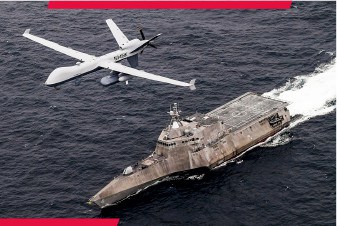
Curtiss-Wright Defense Solutions supported General Atomics Aeronautical Systems’ (GA-ASI) demonstration of the first successful exchange of Link 16 Tactical Data Link (TDL) data over Global Command and Control System – Maritime (GCCS-M) from an Unmanned Aircraft System (UAS) to U.S. Navy surface ships.
The demonstration took place during U.S. Pacific Fleet’s (PACFLT) Unmanned Integrated Battle Problem 2021 (UxS IBP 21) in San Diego, California, in April.
In support of the demonstration, Curtiss-Wright performed rapid integration of its TCG LinkPRO TDL processing software for the GA-ASI MQ-9A Block 5 UAS, where the UAS acted as a surrogate for the MQ-9B SeaGuardian, providing Link 16 data communications capability both in the air and on the ground.
“We are proud to have supported General Atomics’ successful first demonstration of Link 16 tactical data link exchange between an unmanned aerial systems and Navy surface ships,” said Chris Wiltsey, Senior Vice President and General Manager, Curtiss-Wright Defense Solutions.
“This was the first UAS application in a Navy exercise for the proven capabilities of LinkPRO software, and enabled us to highlight our rapid integration capabilities. We look forward to growing opportunities to support unmanned aerial platforms with our high fidelity TDL processing engine.”
During the exercise, General Atomics was able to demonstrate multiple TDL capabilities for the MQ-9 UAS using LinkPRO software:
- Operated as the Link 16 Network Time Reference. The MQ-9’s long loiter time and advantaged position of elevation allowed it to hold the network together and eliminate communication loss and fragmented networks.
- Provided buoy locations, subsurface contacts, and subsurface tracks to be detected and shared with P-8s and the entire network.
- Provided on-call buoy drops for key tactical situations and shared the buoy data over Link 16.
- Propagated surface tracks from the MQ-9’s internal maritime radar capability to Link 16.
- Shared track management information with other network participants as they on-boarded and off-boarded the mission.
- MQ-9’s Link 16 datalink operators were able to perform their function from the safety of ground-based locations.












